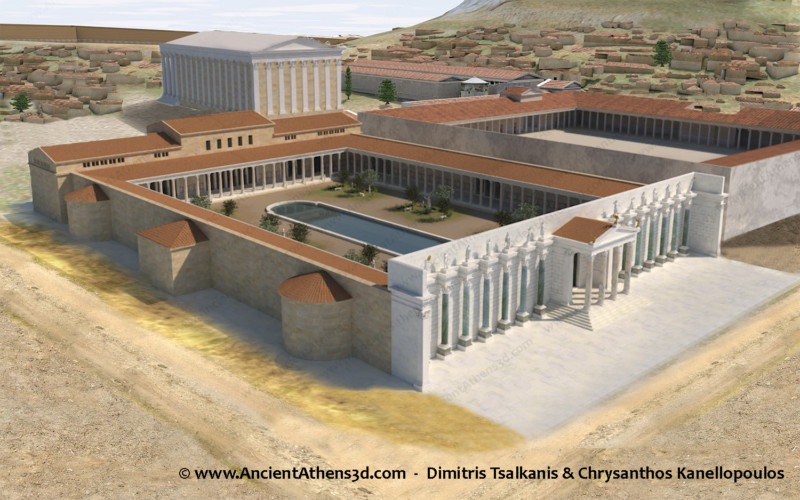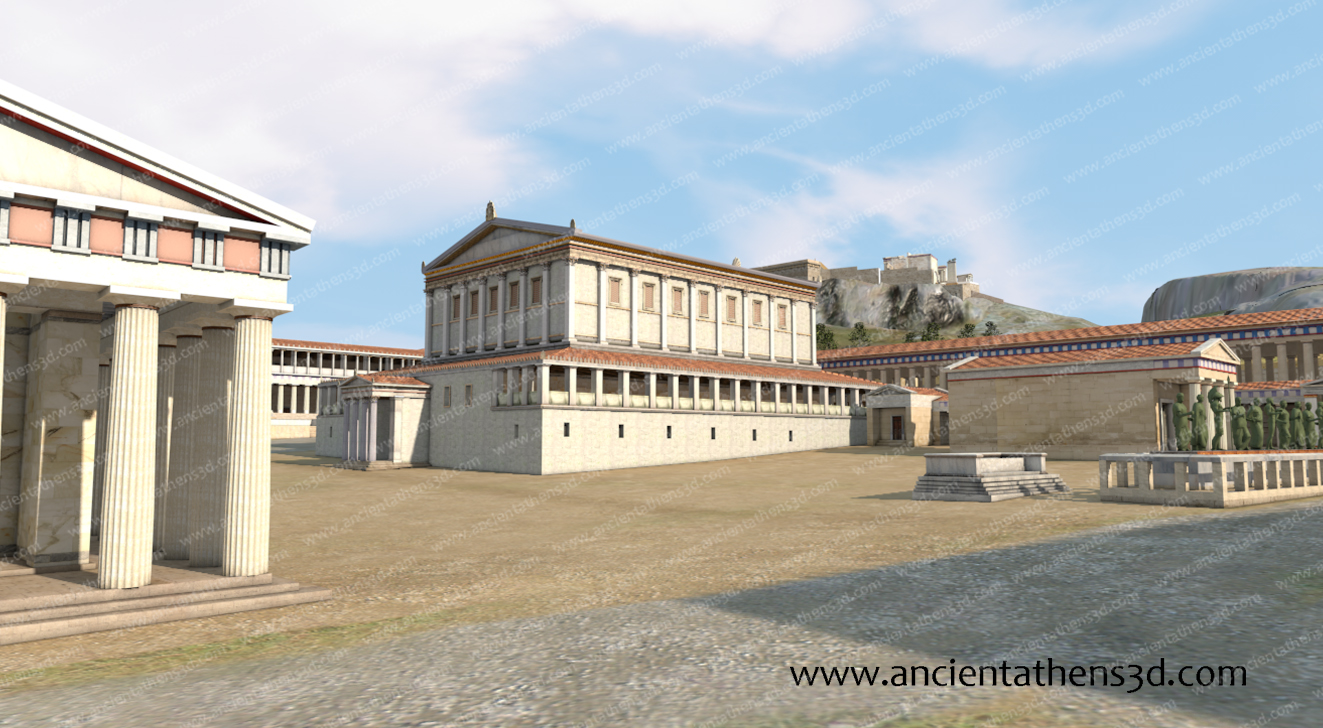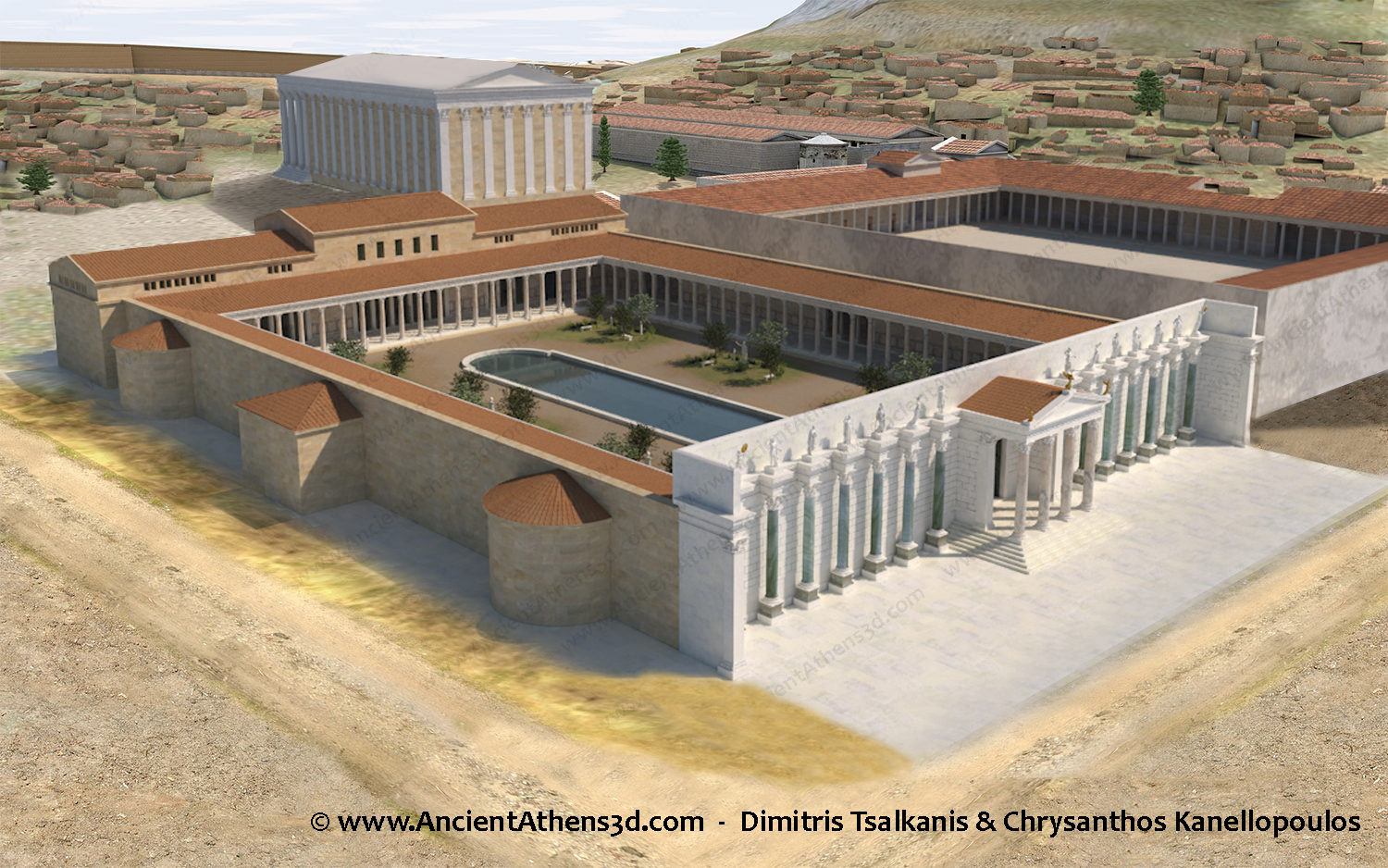Hadrian’s Library (ca 132 AD)
Τhe imperial forum termed conventionally the Library was Hadrian’s response to the neighboring forum of Ceasar and Augustus, now known as the “Roman Agora”. It was constructed in around 132 AD and in order for the new compound to be founded, 24 standard house blocks of a Roman city were expropriated and demolished.
CREDITS:
The models of the reconstructions are after the survey and CAD plans by Chrysanthos Kanellopoulos, professor of Archaeology in the University of Athens and were created by Dimitris Tsalkanis for Ancient Athens 3d.
The Nikae above the columns of the west facade are after Dimitris Sourlas, archaeologist in the Ephorate of Antiquities of Athens, 2018.
Nike Acroterion sculptures © 2019 John Goodinson.
We thank the professors of Archaeology of the University of Athens Stylianos Katakis, Dimitrios Plantzos and Georgios Pallis for their participation.
Creator of the roman toga: Anastasis Keramaris.
The Library of Hadrian is of rectangular plan, measuring aproximately 119×89 metres. It had an internal enclosure was embellished with a portico of 100 columns, in the form of a garden with a large pool in the centre. In the east part were the halls were the books were and the amphitheaters, while smaller halls served as reading rooms.
In each one of the north and south side there were 3 “exedrae“, niches of semicircular and rectangular shape, which were probably used for lectures. The ancient writer Pausanias, while visiting Athens, briefly describes the Library as one of the most important buildings of Hadrian in the city:| Ἀδριανὸς δὲ κατεσκευάσατο μὲν καὶ ἄλλα Ἀθηναίοις, ναὸν Ἥρας καὶ Διὸς Πανελληνίου καὶ θεοῖς τοῖς πᾶσιν ἱερὸν κοινόν, τὰ δὲ ἐπιφανέστατα ἑκατόν εἰσι κίονες Φρυγίου λίθου· πεποίηνται δὲ καὶ ταῖς στοαῖς κατὰ τὰ αὐτὰ οἱ τοῖχοι. (Παυσανίου Ελλάδος Περιήγησις – Αττικά, 18.9) | [Hadrian constructed more buildings in Athens, like the temple of Hera and Zeus Panhellenios, the common sanctuary of all the gods (Pantheon), but of great importance is the one with the one hundred columns made of phrygian stone (the library). In the same material the stoas and the walls are made.] |
The western façade
The one and only entrance to the building was located in its western side.
The façade was embellished with a propylon constructed with four corinthian columns made of pink marble from Phrygia and with columns made of green cipollino rock, quarried and transported from the island of Euboea from imperial property quarries. Upon each column must have stood Nikae and gods statues, sculpted in white marble from the Penteli mountain of Attica.The garden and the portico
While entering the building from the Propylon, the visitors found themselves inside a portico, in front of the big rectangular garden.
Unlike the adjacent busy and loud, commercial, forum of Ceasar and Augustus, Hadrian’s forum, adorned with a garden and a 60 meter long pool, would be a quiet and peaceful island within the hustle and bustle of the city. The enclosure was embellished with a portico of 100 columns made of Phrygian marble (pavonazzetto), pink with blueish veins. The quarries, located in Phrygia -today in Turkey- were imperial property. The Pantheon, a colossal temple dedicated by Hadrian to the worship of all gods, concealed behind the enclosure of the forum, would be viewed from inside the garden. Today, the nail holes on the walls reveal the courses of the revetment slabs; these were also made of Phrygian marble. An equally luxurious ceiling would have matched the colorful architecture of the portico.The Bibliostasion
In the eastern part of the building, there was a series of rooms. The central and biggest of them is considered to be the “Bibliostasion”; that means the place were the books were kept inside niches with wooden cupboards (armaria). Ιt is debated whether the great eastern hall was the actual library or a hall adorned with statues of the imperial family dedicated to the cult of the emperor. Quite possibly, both functions were housed in the same space.
In his book Description of Attica, 18.9, Pausanias describes the hall of Bibliostasion:
| καὶ οἰκήματα ἐνταῦθά ἐστιν ὀρόφῳ τε ἐπιχρύσῳ καὶ ἀλαβάστρῳ λίθῳ, πρὸς δὲ ἀγάλμασι κεκοσμημένα καὶ γραφαῖς· κατάκειται δὲ ἐς αὐτὰ βιβλία | [… and there are rooms there adorned with gilded roofs and with alabaster stone, as well as with statues and paintings. In them are kept books…] |
The amphitheaters
In the northeast and southeast corners of the Library were two similar spaces designed as amphitheaters with marble seats. These amphitheaters do not look like the known lecture rooms (auditoria) of the ancient world. Quite possibly, these rooms were the meeting places (bouleuteria) of the Panhellenion, a league of Greek city-states established by emperor Hadrian.
Unlike all other revetment features in the compound, the wall surfaces of the amphitheaters were solemnly dressed with slabs of pristine white Pentelic marble.The exedrae































